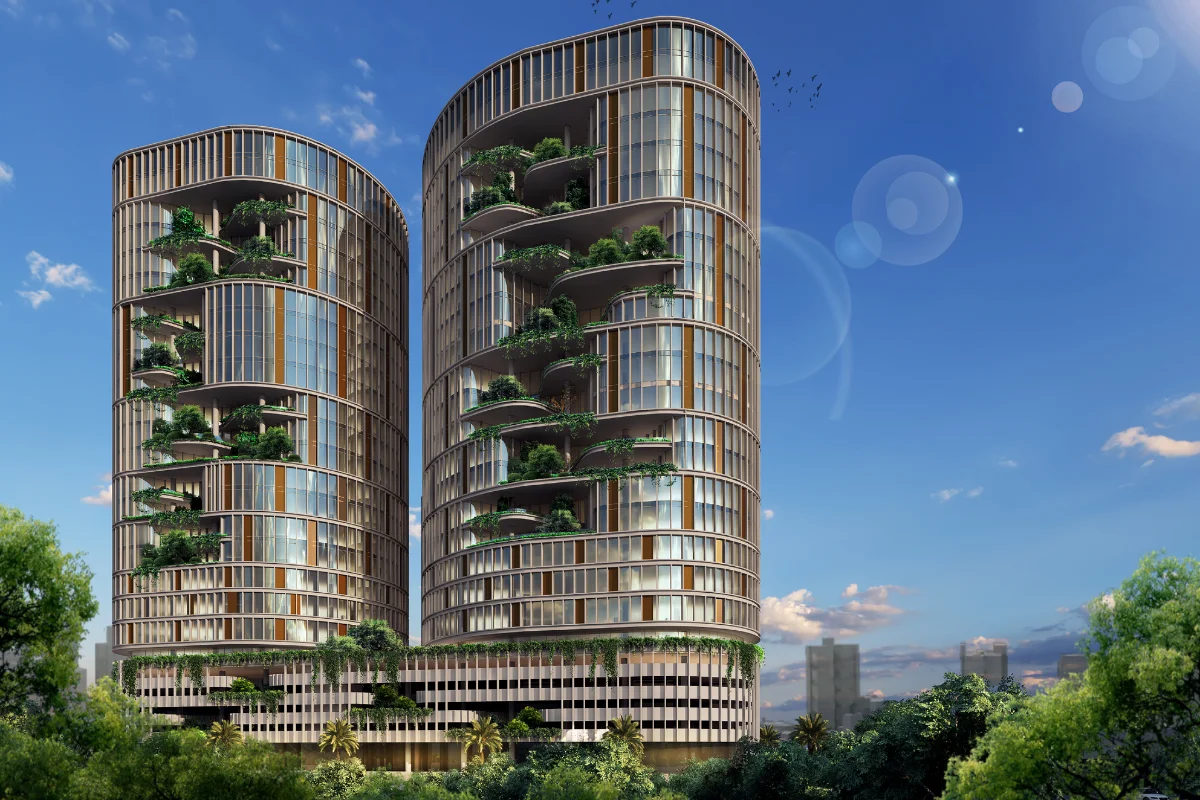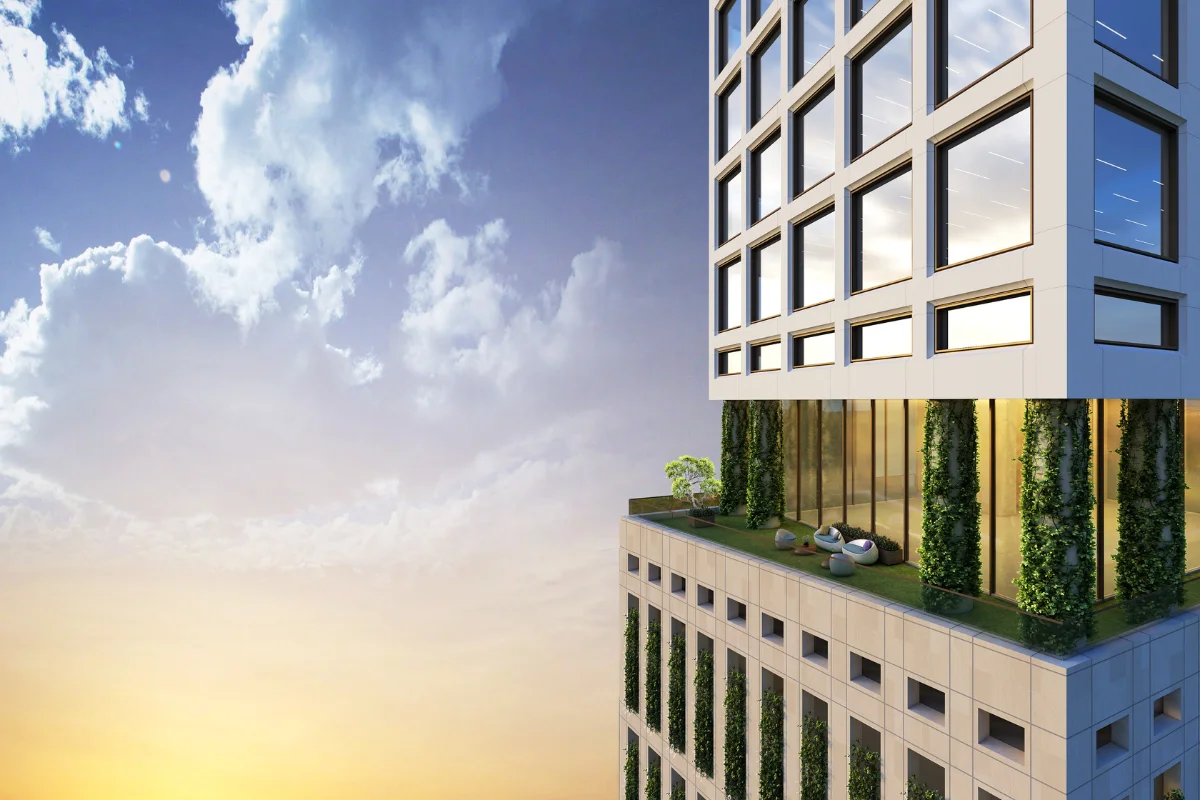Biophilic offices offer emotional resonance, ecological responsibility, and design clarity, beyond meeting aesthetic needs. Much like it is dwelling on Sir Winston Churchill’s saying, “We shape our buildings; thereafter they shape us.” For a space where employees will spend more than a third of their day, this is not a choice but a necessity.
Biophilic Design is an approach to restore the innate connection between humans and nature. The design revolves around integrating experiences wherein the user connects with nature, both directly and indirectly, within the built environment. Design elements such as plants, water bodies, textures derived from natural materials, and strategically planned daylight and ventilation form the key features of a biophilic design.
For commercial office interior design, biophilia contributes to visual aesthetics and much more. In the book, Biophilic Design: The Theory, Science, and Practice of Bringing Buildings to Life, the authors discuss the contributions of nature-integrated spaces to building healthier environments, reduced stress levels of the users, and improved cognitive functions.
For high-density urban offices, the employees end up spending a major portion of their day in the office. For such spaces, the biophilic design concept lays the foundation for bringing nature indoors for a relaxed and productive interior.
Implementing biophilic offices isn’t just a wellness perk; it is a strategic business decision. According to the studies published in the Journal of Environmental Psychology, integrating natural elements into design is the most effective solution to improve concentration, reduce absenteeism, and elevate the morale of employees in a workspace.
If we consider the impact of visual branding, sustainable office interiors portray the brand ethos as forward-thinking and ethical to both clients and visitors. Biophilic design aligns with the standards of ESG (Environmental, Social, and Governance), thus reflecting the organisation with global sustainability mandates.
Moreover, investing in sustainable office design offers measurable returns. Enhanced employee engagement, better indoor air quality and atmosphere, and a reduction in energy consumption contribute to both long-term cost savings and workforce retention. Biophilic offices are workplaces where both business and people thrive.
Biophilia can be easily incorporated into commercial office interior design without the need for a full overhaul. Core components to integrate biophilic design in interior design to dramatically elevate the space:
The colour green is associated with visual stress relievers. Indoor plants and green walls improve indoor air quality significantly.
Opting for open layout plans, strategically designed openings depending on climatic and geographical considerations, and skylights ensures daylight and fresh air in closed spaces.
Sounds of nature, such as flowing water, introduce tranquillity. Fountains, indoor ponds, gaumukh, or small streams are some elements that can be integrated to achieve an atmosphere that reduces mental fatigue and enhances concentration.
Material palette has a huge role in biophilic design. Sustainable materials for interiors include bamboo, cork, reclaimed wood, and natural stone.
Nature can be integrated visually using timber or rattan furniture, and organic curves.
Natural sound absorbers such as moss panels or cork wall treatments mitigate noise and enhance focus.
A sustainable office interior design can be achieved by thoughtfully layering these elements. These considerations are made by keeping in mind the senses of the human body and the psychological impact of space on the human mind.
Talati and Partners keep sustainable modules as the core of their motto. For them, biophilic design is not a fleeting trend but a foundational design language. Talati and Partners’ approach to design is to infuse a space with a sense of place, purpose, and sustainability. They have a deeply contextual and user-centric approach. The vision of Talati and Partners for a sustainable office design aligns with wellness and adaptability, creating environments that evolve with the users.
Key features of the Urban Biophilia project include:
Inducing a serene feel to the space, these green pockets are natural elements of the urban environment that enhance occupant well-being.
Impacting both the facade and the indoors, this feature introduces openness and a seamless connection to nature. They create a dynamic element to the facade at the same time filter the sunlight that streams indoors, thus, contributing to a healthy and productive work environment.
Urban Biophilia is a testament to Talati and Partners’ dedication to creating spaces that elevate employee engagement and promote sustainable design. By integrating these biophilic elements, the Urban Biophilia project brings the benefits of nature to the enclosed workspace. The incorporation of natural features and passive cooling techniques significantly reduces the building’s carbon footprint, exemplifying how commercial office interior design can align with environmental stewardship.
Incorporating biophilia in an existing structure does not require major refurbishments. The biophilic design elements in your office can be integrated with simple strategic planning. Here are some easy and impactful ways to get started:
• Green elements can provide relief to the eyes, especially after long exposure to the screen. Potted plants in the lobbies and near workstations can give an instant uplight.
• Furniture with fluid shapes, and natural curves, and materials with natural textures can integrate the element of nature further.
• During the renovations, sustainable materials for interiors such as reclaimed wood or terrazzo can be opted for.
• For a final touch, soft lighting, essential oil fragrances, and ambient soundscapes enrich the daily experiences.
These simple yet effective strategies make it easier for companies to step into the world of sustainable office interiors, creating environments that support both the planet and people.
The future of work is not just digital; it’s ecological. Biophilic design reintroduces the workspace to us as living ecosystems, rather than static enclosures.
A biophilic office is more than a trend; it’s a movement towards workspaces that breathe, evolve, and inspire.



